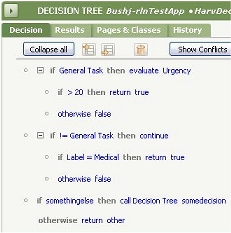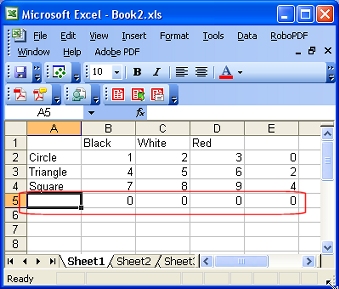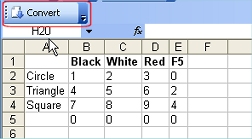Show
all
C-465You can create a flow, decision table, decision tree, or
map value rule from a Windows file in an appropriate format, following a
guided sequence of steps. The uploaded file becomes a starting definition
of the rule. This capability is called rule harvesting. The
original file remains attached to the rule as a Custom Field value.
 Basics
Basics
- If you have an Excel spreadsheet file (XLS file type) that
supports an automated decision similar to those provided by a
decision table or map value, you can upload the spreadsheet.
- If you have a Visio diagram (VSD file) that uses closed shapes
and arrows to present a business process, you can upload the
diagram and use it to start a flow rule.
- If you have an XML file that corresponds to the BPEL 1.1
specification or to Pegasystems' published XML Schema
(
Publicflow.xml) for flows to represent a process, you
can upload the file to create a corresponding draft flow rule.
VIDOD 1/28/08
- For decision trees, a text file (TXT file type) containing a
tree in a formal syntax can be the basis of the decision tree rule.
See below.
- If you have an XML file produced in Proforma's ProVision
CIF 1.0 format, you can upload the file to create a corresponding
draft flow rule. C-2425
Resuming the wizard
This wizard creates a work object with the prefix
pxAT-. To find open wizard work objects, select  > Application > Tools > All Wizards
> Application > Tools > All Wizards
 Starting the
wizard
Starting the
wizard
- Set the appropriate work pool, by selecting BYRNB 2/17/10 Switch Work Pool >work pool name from the Application menu.
- Select BYRNB 2/17/10
 > Integration > Tools > Import > Rule from
File.... .
> Integration > Tools > Import > Rule from
File.... .
- Complete the forms in the screen flow. For guidance, see
Help — Rule-from-File
wizard.
 Harvesting a TXT
file to a decision tree rule
Harvesting a TXT
file to a decision tree rule
To harvest a decision tree rule from a text file, prepare a file in
the following format: KHATV 4/15/05 JOHNI
- Create a file with the TXT file type.
- Use zero or more tab characters to indent the text, reflecting
the levels of the tree.
- Include the keywords
EVALUATE, IF,
CALL, RETURN, THEN,
CONTINUE, OTHERWISE, and
RETURN in uppercase. These have the same meaning as
the corresponding elements in the rule. NORIR 9/7/06 may not
need uppercase
- Your file may include expressions and property references, in
the exact case.
The formal syntax in approximate Backus-Naur form is:
[EVALUATE] <propertyname>
IF [NOT] <expression> THEN [CONTINUE | EVALUATE
<expression> |
%CALL <treename> | CALL DECISIONTREE <treename
> !RETURN <expression>
OTHERWISE [RETURN] <expression>
where % indicates a horizontal tab character. Line endings are
significant. Extra spaces are ignored. For example:
EVALUATE .BallorStrike
%IF ((.Height > 4) &&
.NoSwing && .BatterNotStruck)) THEN CONTINUE
% %IF
(Height > 3) THEN RETURN "Ball"
% %IF
(Height < 1) THEN RETURN "Ball"
OTHERWISE RETURN "Strike"
where % indicates a horizontal tab character. Another example:
NORIR 9/7/06
 EVALUATE Label
EVALUATE Label
IF General Task THEN EVALUATE Urgency
%IF > 20 THEN RETURN true
%OTHERWISE RETURN false
IF NOT General Task THEN CONTINUE
%If Label = Medical THEN RETURN true
%OTHERWISE RETURN false
IF somethingelse THEN call somedecision
OTHERWISE RETURN other
When imported with this wizard, the system
creates a decision tree similar
to the image shown at right. NORIR 3/13/07
 Harvesting a
Public flow XML file to a flow
Harvesting a
Public flow XML file to a flow
Process Commander's internal XML representation of a flow rule
conforms closely to the XML schema stored in the standard text file
rule Harvest.Publicflow.xml. You can use the
Rule-from-File wizard to import an XML file conforming to this schema
and create a draft flow rule. To work with this schema:
- Open the Harvest.Publicflow.xml text file
rule
- Export the text to a local drive.
- Change the file type to "xsd" from
"xml".
- Validate your XML file against the XSD.
- Start the Rule-from-File wizard.
XML files that conform to this schema are syntactically correct,
and the resulting flow rule can be edited in Visio. VIDOD MARIK
SARTM 1/28/08
On the Attach File wizard step, select
Public Flow as the Format value.
 Harvesting a
BPEL 1.1 XML file to a flow
Harvesting a
BPEL 1.1 XML file to a flow
When harvesting an XML file in BPEL 1.1 format, the wizard makes
the following conversions: VagueC-2159
BPEL 1.1 element
|
Flow shape
|
| flow, sequence, and scope |
New flow rule |
| assign |
Utility |
| receive |
AssignmentService |
| flow, sequence, and scope |
Call or branch to subflow |
| invoke and reply |
Integrator |
partnerlink, partner,
CorrelationSet |
N/A |
| throw |
Utility to set a ticket |
| switch |
Call or branch to subflow |
| while |
Call or branch to subflow |
 Harvesting an
Excel worksheet to a map value rule
Harvesting an
Excel worksheet to a map value rule
To create a map value rule (Rule-Obj-MapValue rule
type) from an Excel worksheet, BUG-1697 NORIR
-
 Create an Excel worksheet that
contains the values to become the Matrix tab as constants. Leave cell A1 blank. In
cells A2, A3, ..., enter text that is to become the column headers.
In cells B1, C1, ..., enter text that is to become the row headers.
Enter constants in a final row (with the first column blank) for
the Default row, and similarly enter a rightmost Default column.
(If the condition value is simply a number, then format the column
cells as text, not numbers, and type "=" or"
==" before the number. For example, =1000.
BUG-9453
Create an Excel worksheet that
contains the values to become the Matrix tab as constants. Leave cell A1 blank. In
cells A2, A3, ..., enter text that is to become the column headers.
In cells B1, C1, ..., enter text that is to become the row headers.
Enter constants in a final row (with the first column blank) for
the Default row, and similarly enter a rightmost Default column.
(If the condition value is simply a number, then format the column
cells as text, not numbers, and type "=" or"
==" before the number. For example, =1000.
BUG-9453
- Complete all steps of the Rule-from-File wizard. After you
upload the XLS file, it becomes a custom field value on the
History tab of the rule.
- After the Rule-from-File wizard completes, further processing
is required. Click the pencil icon (
 ) to open the map value rule.
) to open the map value rule.
- Click Edit
In Excel. If prompted, adjust macro security to
Medium or lower to enable Excel macros.
-
 When
initial macro execution ends, click Convert in the upper left corner. Close Excel. Click
Yes when
prompted to save the changed Excel file, to apply the changes to
the Map Value rule form.
When
initial macro execution ends, click Convert in the upper left corner. Close Excel. Click
Yes when
prompted to save the changed Excel file, to apply the changes to
the Map Value rule form.
- Update the Input tab of the Map
Value form as necessary. Optionally, select the Row
Property and Column Property
properties.
- Update the History tab and other
tabs as desired. Save the form.
 Tools, accelerators, and wizards
Tools, accelerators, and wizards
![]() Harvesting a TXT
file to a decision tree rule
Harvesting a TXT
file to a decision tree rule
![]() Harvesting a
Public flow XML file to a flow
Harvesting a
Public flow XML file to a flow
![]() Harvesting a
BPEL 1.1 XML file to a flow
Harvesting a
BPEL 1.1 XML file to a flow
![]() Harvesting an
Excel worksheet to a map value rule
Harvesting an
Excel worksheet to a map value rule

